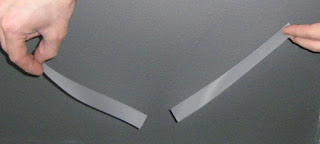Bare bones answer: electrons being attracted to protons.
Molecules are collections of atoms. Within that molecule the distribution of protons (positively charged) and electrons (negatively charge) is not even. Often, but not always, there are more negative charges on one side and more positive on another. The negative side wants to stick to another positive sided molecule and vice versa. Broadly speaking these are called van der Waals forces or intermolecular forces if the attraction does not share electrons (well, for the most part...).
Chemists and physicists further break those broad categories into dipole-dipole forces (between molecules of differing charge distribution), hydrogen bonding (also a dipole molecule, but with a higher contrast between positive/negative), and ionic interactions (between ions), London dispersion forces (temporary redistribution of electrons resulting in charge asymmetry) and others shown below.
You can see these forces in action with tape. Stick some tape on a substance and then pull it up and some of whatever it was stuck to will invisibly now be on the tape in the form of stolen electrons (this shows there was at least some electron sharing, but not to the level of covalent or ionic bonds).
Cool animation of all this: http://web.mst.edu/~gbert/INTERACT/intermolecular.HTM
Pic from: http://www.science.uwaterloo.ca/~cchieh/cact/applychem/hydration.html
Pic from: http://en.wikipedia.org/wiki/Static_electricity
*http://www.dummies.com/how-to/content/sticky-chemistry-intermolecular-forces.html
http://www.ccmr.cornell.edu/education/ask/index.html?quid=1118
http://www.npr.org/templates/story/story.php?storyId=12507754
Molecules are collections of atoms. Within that molecule the distribution of protons (positively charged) and electrons (negatively charge) is not even. Often, but not always, there are more negative charges on one side and more positive on another. The negative side wants to stick to another positive sided molecule and vice versa. Broadly speaking these are called van der Waals forces or intermolecular forces if the attraction does not share electrons (well, for the most part...).
Chemists and physicists further break those broad categories into dipole-dipole forces (between molecules of differing charge distribution), hydrogen bonding (also a dipole molecule, but with a higher contrast between positive/negative), and ionic interactions (between ions), London dispersion forces (temporary redistribution of electrons resulting in charge asymmetry) and others shown below.

You can see these forces in action with tape. Stick some tape on a substance and then pull it up and some of whatever it was stuck to will invisibly now be on the tape in the form of stolen electrons (this shows there was at least some electron sharing, but not to the level of covalent or ionic bonds).
 |
| These two pieces were stuck together so that they now have the same charge and therefore repel each other |
Cool animation of all this: http://web.mst.edu/~gbert/INTERACT/intermolecular.HTM
Pic from: http://www.science.uwaterloo.ca/~cchieh/cact/applychem/hydration.html
Pic from: http://en.wikipedia.org/wiki/Static_electricity
*http://www.dummies.com/how-to/content/sticky-chemistry-intermolecular-forces.html
http://www.ccmr.cornell.edu/education/ask/index.html?quid=1118
http://www.npr.org/templates/story/story.php?storyId=12507754

No comments:
Post a Comment
Please comment! You can comment anonymously! Please send ideas and topics to research and post on!!!